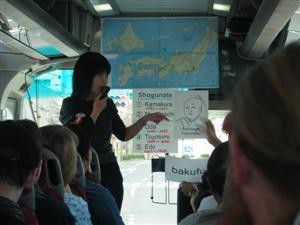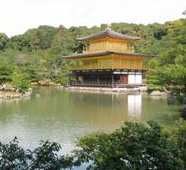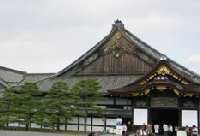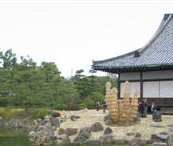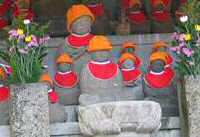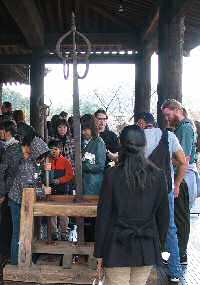Crashing Japan
Pop Japan Travel: Day 1
by Christopher Macdonald,
Japan is, for anime fans, the equivalent of Mecca to those of Islamic faith. While we aren't required to visit Japan at least once in our lives, you'd be hard pressed to find an anime fan who doesn't want to visit Japan at some point. The sooner the better.
With the growing North American anime fan-base, it's no surprise that a few companies have popped up that offer guided tours of Japanese pop-culture locations. One such company is Pop Japan Travel, a subsidiary of Digital Manga.
Earlier this year, I was invited to go with one of the tour groups and experience it firsthand. I thought it would be the perfect opportunity for ANN readers to get a look at a Pop Japan tour, as well as learn a bit more about that magnificent country so lauded by their fellow anime fans. My trip to Japan was hastily planned (there were less than three weeks between the day I decided to go, and the date of my departure), which I really don't recommend. Granted, the trip doesn't much planning since PJT handles everything, but it's still nice to have time to prepare everything on your end, and have some downtime to enjoy the anticipation—and to gloat to all your otaku friends.
Day 0
The Flight Out
The actual Pop Japan Travel tour was slated to start at LAX, but for me, my trip started much earlier and much further away. I left for the airport at an eye-rubbing 3am, hoping to get to the airport right as the ticket counters opened so I could beat all the check-in lines for my 6am flight out of Montreal.
The actual tour started at Tom Bradley terminal at LAX, boasting the largest PJT group ever, with around 35 people. While I was flying to LA, I kind of wondered what the other tour people would look like—stereotypical otaku maybe? Or everyday people? Turns out, the latter. Most of the folks looked like “normal” people, and even though there were a few anime t-shirts, there was nothing that screamed “otaku!!” The only person that caught my eye was a woman named Yumiko from the travel agency who was decked out head to foot in Hello Kitty gear.
Once we hit Osaka, we were left to exchange money while the tour guides collected our passports and fetched our JR passes. If you ever head to Japan, make sure to bring cash or travelers checks. There's no place at the airport to use a North American bank card, and they don't accept credit cards (see sidebar).
The train from the airport to Kyoto was around 45 minutes long, which gave tour members plenty of time to figure out from the tour guide Isaac what plans the week held. Isaac is one of those people who can turn just about anything into a joke, which is great because when it comes time for mundane conversations on where to eat breakfast, a few extra laughs are always appreciated. Watching him interact with the locals provided even more chuckles—it's not every day they see a 6-foot tall African American with blazing red hair, which earned him the nickname “Aka-san”... or Mr. Red.
During the train ride, I got the opportunity to learn a bit more about the other people on the tour. Ranging from folks in their late teens to their fifties, everyone professed to be an anime fan, thought at least one person there said he would've been happy to take a completely cultural tour of Japan even if it didn't touch any aspects of anime fandom. Of course, everyone was beyond excited. Some people wanted to come on the trip so badly that they took out personal loans or skipped a week of classes.
The hotel we stayed in the first night was a fairly typical 3-star fare. Because I was traveling alone, I was paired up with another solo traveler to share a room. For those who crave privacy and want their own room, the option can be purchased for an additional $70 a night.
After midnight, I finally had my first run-in with a Japanese convenience store. Right across the street was a LAWSON, a nation-wide convenience store chain a lot like 7-11. Of course, being Japan, even that late at night there were still a couple of men of varying ages (teens to middle age) standing in front of a magazine rack reading mangabon like Shonen Jump. I didn't have Japanese cash yet, but luckily, Lawsons actually accept credit cards, a very deceptive introduction to what turns out to be the truth about credit cards in Japan.
Day 1 – Part 1
The hotel had two restaurants open for breakfast, one Japanese and one western. Interestingly, most of the hotel's Japanese patrons went to the western restaurant, so there was no wait at the other one (though both styles of breakfast are more or less equally popular in Japan). Typically, a Japanese breakfast consists of rice, miso soup, fish or eggs, and pickled vegetables. The restaurant I ate at served something similar, only with rice soup (congee) instead of rice and green tea jello on the side. I sat down with three other tour members and tried to figure out all the ingredients in our food. To this day, I still don't know what that white thing was...
We were originally scheduled to go to Toei studio park first, followed by several castles and temples. However our guide, Ms. KIKUE (KIKUE-san), decided that it would make more sense to visit the studio park in the afternoon and the shrines in the morning, because there were plenty of places to eat lunch close to the third shrine. She told me later that this actually caused quite a stir with the other Japanese tour guide. KIKUE-san spent a few years in the USA as a student and picked up a few American habits, as well as a new outlook on Japanese habits. Japanese society is very structured and rigid, and very few things are done spur of the moment. So despite that fact that it was a logical change, the other guide wasn't sure if it was a good idea to change the day's plan, simply because it was a change.
On our way to our first stop, we passed a huge kanji character embedded in the side of Mount Nyoigatake. The character “大” is pronounced “Dai” and means “great” in Chinese and Japanese. It was literally great, since the horizontal stroke of the character was 80 meters (262.5 ft) long! There are several such characters spread out around Kyoto. These characters are lit on fire every year for Daimonji Gozan Okuribi, a Buddhist fire ceremony that marks the end of the Japanese festival of the dead.
First Stop: Kinkaku-ji
The Golden Pavilion of Kinkaku-ji was built in 1397 by Ashikaga Yoshimitsu, the third Shogun of the Muromachi Shogunate. The pavilion served as Yoshimitsu's retirement home until his death in 1408. Several years later, as per his wishes, the pavilion became a Buddhist temple. The temple itself is a small pagoda, surrounded by an expansive garden. The garden is the real attraction here, and you can spend a good 45 minutes walking through it. There are numerous little shops selling souvenirs in the garden, but there's nothing really worth buying, since half of it doesn't even have anything to do with the temple.
Second Stop: Nijo Castle
Our second stop was Nijo Castle. This castle was built by Tokugawa Ieyasu, founder of the Tokugawa Shogunate, in 1603 as a Kyoto residence. Home of the emperor, Kyoto was the official capital of Japan at the time, even though the shogunate ruled from Tokugawa's hometown, Edo (now called Tokyo), until the Meiji Restoration. The Kyoto castle was used primarily for meetings with the emperor. The castle is a large wooden mansion, surrounded by stone walls and a moat. Most of the original decorations remain or have since then been restored.
I was immediately drawn to a comparison with Versailles Palace in France, which I visited last October. Nijo was built 80 years before Versailles and while it isn't nearly as lavish, it maintains a similar decorum, beauty and function. Like Versailles, long before you reach the master's chambers, you pass numerous waiting rooms, guard rooms and attendants' rooms. Each room has a purpose, and for most of them, signs and audio commentary explain the purpose. In addition, KIKUE-san provided additional information and stories pertaining to each room. One of the most interesting aspects of the mansion are its “nightingale floors” (uguisu-bari). They were designed to creak in a high pitch, almost like a cricket's chirp, whenever walked on. This made it impossible for assassins to move about silently in the mansion.
The gardens surrounding the palace are well-kept and extremely beautiful, fitting for any ruler. They can be comfortably roamed within 30 minutes.
Third Stop: Kiyomizudera Temple
After Nijo Castle, the tour group headed to Kiyomizudera Temple, a popular Kyoto landmark. Legend has it that this mountain-side temple was first established as a small chapel in 778 AD and expanded 20 years later. The temple can be reached from the parking lot along bustling commercial streets and is situated on a large wooden terrace atop a hill overlooking the temple grounds and the city. Truly a tourist area, the street is lined with souvenir shops and restaurants. Again I am reminded of France, only this time it's the road leading up to Mont St. Michel
At the entrance of the temple there is a fountain where visitors can wash up and drink before entering. The first set of items on display is a pair of heavy metal staves and a pair of similarly heavy metal walking shoes. These were supposedly used by monks to develop their strength. The heavier of the two staves weighs something over 200 pounds, and while many people tried, only one member of the group could lift it off the ground. Inside the temple are numerous shrines devoted to various subjects. One shrine was devoted to unborn children and featured many stone statues representing the children. Each statue wore a hat and bib that appear to have been hand-knitted. Another area of the temple featured two stones about twenty-five feet apart; it is said that if someone can walk from one stone to the other, with their eyes closed, they will be lucky in love. Incidentally, the temple is popular amongst young people who come to pray for romantic success.
And of course, like Nijo and Kinkaku-ji, the gardens surrounding Kiyomizu are quite beautiful, but of a significantly wilder and less tended nature.
After touring the temple, I headed back down towards the parking lot, looking for somewhere to eat along the way. This brings me to a small problem, entirely of my own creation, that I encountered on my visit to Japan. I had planned on using my ATM Card to withdraw cash as I needed it, but I accidentally left the card at home just minutes before leaving, and all I had on me was my credit card. My problem was further compounded because I never use my credit cart at ATMs, so I don't know the PIN#. In most developed countries none of this would have posed any problem, but Japan is different in this regard. In a very “touristy” area I had to go into over 10 different, nice restaurants before I found one that accepted Visa. Japan is a cash only society.
Next: Toei Studio Park, the Bullet Train and Anime Shopping in Osaka.

The Pop Japan Travel Posse Prepares to Enter Kiyomizudera Temple
With the growing North American anime fan-base, it's no surprise that a few companies have popped up that offer guided tours of Japanese pop-culture locations. One such company is Pop Japan Travel, a subsidiary of Digital Manga.
Earlier this year, I was invited to go with one of the tour groups and experience it firsthand. I thought it would be the perfect opportunity for ANN readers to get a look at a Pop Japan tour, as well as learn a bit more about that magnificent country so lauded by their fellow anime fans. My trip to Japan was hastily planned (there were less than three weeks between the day I decided to go, and the date of my departure), which I really don't recommend. Granted, the trip doesn't much planning since PJT handles everything, but it's still nice to have time to prepare everything on your end, and have some downtime to enjoy the anticipation—and to gloat to all your otaku friends.
Sorry, Cash Only When telling my friend Dan, who lives in Tokyo, about my trouble using a credit card in Japan, he stated, “Japan doesn't need credit cards, it has the most advanced cash system in the world.” Dan illustrated this point by explaining that every month, when it's time for him to pay his rent, he goes to his bank's ABM, withdraws 90,000 yen, crosses the street to his landlord's bank, and deposits the 90,000 yen in cash into his landlord's account. The machine verifies that he has submitted the proper amount of cash and gives him a receipt, as well as change if necessary. True, it's very advanced, but to me this is similar to stating that Mongolia doesn't need planes, trains or automobiles because they have the world's most advanced horses.When you travel in North America, Europe, and even other places in Asia, a bank card and a credit card will get you pretty much everything you need. Not so in Japan. Very few establishments accept credit cards and the only bank machines where you can use foreign bank cards are the bank machines at post offices. What's more, many ATMs only operate during business hours, while some operate from 8am to 8pm, and a few are even open on Saturdays. Need cash on Sunday? Too bad. Foreigners who live in Japan find it extremely hard to actually get a credit card. Many banks are believed to categorically reject any credit card application that comes from a non-citizen resident. But even if you manage to get a Japanese credit card, expecting it to behave like your credit card back home, it could lead to a very nasty surprise. Most banks automatically deduct the entire balance of your credit card from you bank account every month, so if you go on a spending spree and plan to pay for it over several months, you could find yourself suddenly penniless, with you bank account and credit card both frozen. Although the use and acceptance of credit cards is growing very quickly in Japan, it still isn't nearly a prevalent as it is in North America. Stores that aren't part of large chains, especially those outside of major cities, are less likely to accept credit cards. But even in downtown Tokyo it is very possible to walk into a nice restaurant that doesn't accept credit cards. Personal checks are essentially unheard of in Japan. Most Japanese people carry around several times more cash in their wallet than the typical middle class North American. Having several hundred dollars worth of yen in one's wallet is standard fair. As Aka-san stated, “Mug someone in Japan, and you'll be rich.” |
Day 0
The Flight Out
The actual Pop Japan Travel tour was slated to start at LAX, but for me, my trip started much earlier and much further away. I left for the airport at an eye-rubbing 3am, hoping to get to the airport right as the ticket counters opened so I could beat all the check-in lines for my 6am flight out of Montreal.
| Travel tip: Skipping a night of sleep is the perfect cure for jetlag, especially if you're planning a morning trip overseas. Japan is 13 hours ahead of Montreal (Eastern Standard Time, for reference), which means if you're leaving the western seaboard in the morning, you won't get to Osaka until evening... when your body thinks it's late morning. Besides, it's been my experience that not getting any sleep at all is a lot better than only getting an hour or two. |
The actual tour started at Tom Bradley terminal at LAX, boasting the largest PJT group ever, with around 35 people. While I was flying to LA, I kind of wondered what the other tour people would look like—stereotypical otaku maybe? Or everyday people? Turns out, the latter. Most of the folks looked like “normal” people, and even though there were a few anime t-shirts, there was nothing that screamed “otaku!!” The only person that caught my eye was a woman named Yumiko from the travel agency who was decked out head to foot in Hello Kitty gear.
| Suggestions on passing the time:What are you going to do on a 13 hour flight (besides watch potentially terrible in-flight movies)? Read! And prep for your trip, all at the same time! On my flight to Osaka, I sat down with Cruising the Anime City: An Otaku Guide to Neo Tokyo by Patrick Macias and Tomohiro Machiyama. The book is an indispensable guide to any anime fan visiting, or thinking of visiting Tokyo, and I'm glad I took the time to read it. Turns out, several other people on the tour brought the book along too. |
Once we hit Osaka, we were left to exchange money while the tour guides collected our passports and fetched our JR passes. If you ever head to Japan, make sure to bring cash or travelers checks. There's no place at the airport to use a North American bank card, and they don't accept credit cards (see sidebar).
| JR Passes: The website for the JR Pass sports the following line right on its front page: “JAPAN RAIL PASS is a traveler's best friend. With the PASS you can freely board almost any train on these JR Group lines throughout the country.” I couldn't agree with the first line more. If you plan on visiting Japan for more than a few days and you want to be able to travel freely, get a JR Pass. JR Passes are special tickets available only to foreign travelers visiting Japan to sight-see. In order to get one, you must either be a foreign tourist visiting Japan as a "Temporary Visitor" from abroad, or a Japanese national living in a foreign country. The handy passes come in 7-day, 14-day, and 21-day varieties, with two options for each: Ordinary, and the more expensive Green. The JR Pass lets you ride on all the JR Group Railways, all the JR Bus Companies, and it gives you ferry access too. Of course, the JR pass won't be good for every single possible public transportation system in Japan, but with the huge expansive coverage, there's probably not a single place you couldn't reach using the handy pass. |
The train from the airport to Kyoto was around 45 minutes long, which gave tour members plenty of time to figure out from the tour guide Isaac what plans the week held. Isaac is one of those people who can turn just about anything into a joke, which is great because when it comes time for mundane conversations on where to eat breakfast, a few extra laughs are always appreciated. Watching him interact with the locals provided even more chuckles—it's not every day they see a 6-foot tall African American with blazing red hair, which earned him the nickname “Aka-san”... or Mr. Red.
During the train ride, I got the opportunity to learn a bit more about the other people on the tour. Ranging from folks in their late teens to their fifties, everyone professed to be an anime fan, thought at least one person there said he would've been happy to take a completely cultural tour of Japan even if it didn't touch any aspects of anime fandom. Of course, everyone was beyond excited. Some people wanted to come on the trip so badly that they took out personal loans or skipped a week of classes.
The hotel we stayed in the first night was a fairly typical 3-star fare. Because I was traveling alone, I was paired up with another solo traveler to share a room. For those who crave privacy and want their own room, the option can be purchased for an additional $70 a night.
After midnight, I finally had my first run-in with a Japanese convenience store. Right across the street was a LAWSON, a nation-wide convenience store chain a lot like 7-11. Of course, being Japan, even that late at night there were still a couple of men of varying ages (teens to middle age) standing in front of a magazine rack reading mangabon like Shonen Jump. I didn't have Japanese cash yet, but luckily, Lawsons actually accept credit cards, a very deceptive introduction to what turns out to be the truth about credit cards in Japan.
Day 1 – Part 1
The hotel had two restaurants open for breakfast, one Japanese and one western. Interestingly, most of the hotel's Japanese patrons went to the western restaurant, so there was no wait at the other one (though both styles of breakfast are more or less equally popular in Japan). Typically, a Japanese breakfast consists of rice, miso soup, fish or eggs, and pickled vegetables. The restaurant I ate at served something similar, only with rice soup (congee) instead of rice and green tea jello on the side. I sat down with three other tour members and tried to figure out all the ingredients in our food. To this day, I still don't know what that white thing was...
| Anime on TV: Having some time to kill, I decided to explore something most anime fans are more than curious about—anime on TV. Only one of the stations had anime on, and it took me a while to figure out it was Kindaichi Case Files. Something that surprised me throughout the trip was that there really isn't that much anime on broadcast television. At any given time of the day it's quite possible to turn on the TV, flip through the channels and not find a single anime. A lot more anime is shown on cable, satellite, pay TV, pay per view and video on demand. |
On our way to our first stop, we passed a huge kanji character embedded in the side of Mount Nyoigatake. The character “大” is pronounced “Dai” and means “great” in Chinese and Japanese. It was literally great, since the horizontal stroke of the character was 80 meters (262.5 ft) long! There are several such characters spread out around Kyoto. These characters are lit on fire every year for Daimonji Gozan Okuribi, a Buddhist fire ceremony that marks the end of the Japanese festival of the dead.
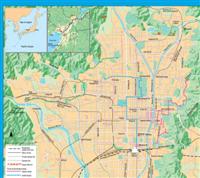 Map of Kyoto Click for Larger Image |
Our second stop was Nijo Castle. This castle was built by Tokugawa Ieyasu, founder of the Tokugawa Shogunate, in 1603 as a Kyoto residence. Home of the emperor, Kyoto was the official capital of Japan at the time, even though the shogunate ruled from Tokugawa's hometown, Edo (now called Tokyo), until the Meiji Restoration. The Kyoto castle was used primarily for meetings with the emperor. The castle is a large wooden mansion, surrounded by stone walls and a moat. Most of the original decorations remain or have since then been restored.
The gardens surrounding the palace are well-kept and extremely beautiful, fitting for any ruler. They can be comfortably roamed within 30 minutes.
Third Stop: Kiyomizudera Temple
After Nijo Castle, the tour group headed to Kiyomizudera Temple, a popular Kyoto landmark. Legend has it that this mountain-side temple was first established as a small chapel in 778 AD and expanded 20 years later. The temple can be reached from the parking lot along bustling commercial streets and is situated on a large wooden terrace atop a hill overlooking the temple grounds and the city. Truly a tourist area, the street is lined with souvenir shops and restaurants. Again I am reminded of France, only this time it's the road leading up to Mont St. Michel
And of course, like Nijo and Kinkaku-ji, the gardens surrounding Kiyomizu are quite beautiful, but of a significantly wilder and less tended nature.
After touring the temple, I headed back down towards the parking lot, looking for somewhere to eat along the way. This brings me to a small problem, entirely of my own creation, that I encountered on my visit to Japan. I had planned on using my ATM Card to withdraw cash as I needed it, but I accidentally left the card at home just minutes before leaving, and all I had on me was my credit card. My problem was further compounded because I never use my credit cart at ATMs, so I don't know the PIN#. In most developed countries none of this would have posed any problem, but Japan is different in this regard. In a very “touristy” area I had to go into over 10 different, nice restaurants before I found one that accepted Visa. Japan is a cash only society.
Next: Toei Studio Park, the Bullet Train and Anime Shopping in Osaka.
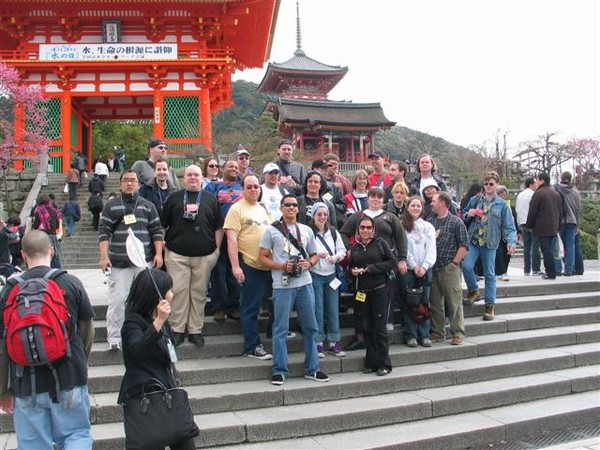
The Pop Japan Travel Posse Prepares to Enter Kiyomizudera Temple
discuss this in the forum (19 posts) |
